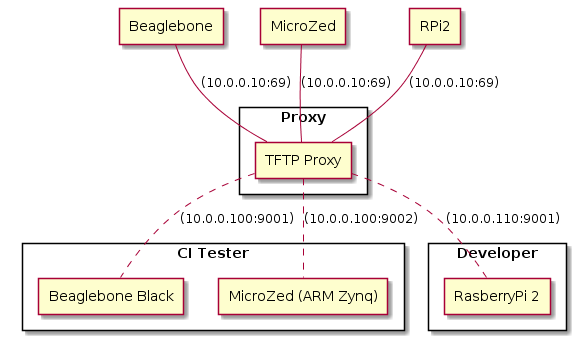14.7. RTEMS TFTP Proxy#
The RTEMS TFTP Proxy (rtems-tftp-proxy) command is an RTEMS tool to simplify hardware testing using the RTEMS Test and Run commands. This command lets a test set up support a number of similarly configured boards running tests at the same time by proxying the TFTP session requests. The TFTP and U-Boot section details the process to run a test executable on a network connected board.
The TFTP Proxy approach does not require any special modifications in a boot loader to work and works with any compliant TFTP boot client.
An identical SD card boot configuration can be used in similar board when a test set up has a number of similar boards. There is no need to specialize boot configurations. The TFTP proxy server identifies each board by MAC address.
A configuration file maps a board’s MAC address to a TFTP server’s IP address and port number. This provides a centralized means to partition hardware in a test rack between members of a team, continuous integration services or any other project demands.
The TFTP port number a proixed service runs with does not need to be the privileged TFTP port number removing the need to be root to run the RTEMS Test or Run commands. Only the TFTP Proxy needs to running as a privileged user. The RTEMS Test and Run commands lets you specified the TFTP port to bind too.
14.7.1. Operation#
A network connected board with a suitable boot loader such as U-Boot is configured to boot using TFTP. The boot loader’s configured TFTP server IP address is the address of the host computer running the TFTP Proxy server or the proxy. The TFTP Proxy runs as root or an administrator as it binds by default to the default TFTP port of 69.
A reset board sends a TFTP read request (RRQ) packet to the host
machine running the TFTP proxy on the standard TFTP port (69). The
proxy server searches the configuration data for a matching MAC
address. A configuration match creates a session, forwarding the
read request to the proxied IP and port.
The response from the proxied server identifies the remote session port number and the proxy server knows the board’s client port number from the initial request. The proxy transfers the TFTP data transparently between the session’s ports until the transfer finishes.
An example configuration is three different types of boards used for RTEMS kernel regression testing and application development.

Fig. 14.1 RTEMS TFTP Proxy Test Lab#
The project has a continuous integration (CI) server on address
10.0.0.100 and two boards, a BeagleBone Black and Xilinx MicroZed
board, are confgured for testing. A developer on another host machine
is using a RaspberryPi to develop an application. The configuration
file is:
;
; Project Foo Test network.
;
[default]
clients = bbb, uzed, rpi2
[bbb]
mac = 1c:ba:8c:96:20:bc
host = 10.0.0.100:9001
[uzed]
mac = 6e:3a:1c:22:aa:5f, 8a:3d:5f:67:55:cb
host = 10.0.0.100:9002
[rpi2]
mac = b8:27:eb:29:6b:bc
host = 10.0.0.110:9001
The MicroZed board can be seen by different MAC addresses depending on how U-Boot starts. As a result both are listed.
14.7.2. Configuration#
The boot image tool is configured by an INI file that is passed to the TFTP proxy on the command line when it starts.
The [default] section has to contain a clients entry that
lists the clients. There needs to be a client section for each listed
client.
A client section header is a client name listed in the clients
record in the defaults section. A client section has to contain a
mac record and a host record. The MAC record is a comma
separated list of MAC addresses in the standard 6 octet hex format
separated by :. A list of MAC addresses will match for any address
listed. The host record is the IP address and port number of the
proxied TFTP server.
14.7.3. Command#
The rtems-tftp-proxy tool runs a TFTP proxy server using a user provided configuration file. The command line options are:
rtems-tftp-proxy
- -h, --help#
Display the command line help.
- -l, --log#
Set the log file name.
- -v, --trace#
Enable trace or debug logging.
- -c CONFIG, --config CONFIG#
The INI format configuration file.
- -B BIND, --bind BIND#
The interface address the proxy binds too. The default is
allwhich means the proxy binds to all interfaces.
- -P PORT, --port PORT#
The port the proxy server binds too. The default is the TFTP standard port of 69. This is a privileged port so if using this port number run the TFTP proxy with root or administrator privileges.
14.7.4. Examples#
The examples show running the TFTP Proxy as a privileged user:
$ sudo rtems-tftp-proxy -c foo-test-lab.ini
Password:
RTEMS Tools - TFTP Proxy, 5.1.0
Command Line: rtems-tftp-proxy -c foo-test-lab.ini
Host: FreeBSD ruru 12.0-RELEASE-p3 FreeBSD 12.0-RELEASE-p3 GENERIC amd64
Python: 3.6.9 (default, Nov 14 2019, 01:16:50) [GCC 4.2.1 Compatible FreeBSD Clang 6.0.1 (tags/RELEASE_601/final 335540)]
Proxy: all:6
